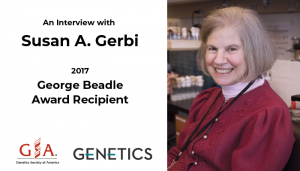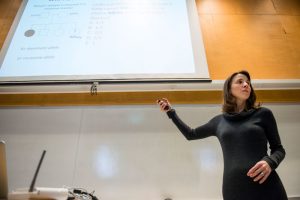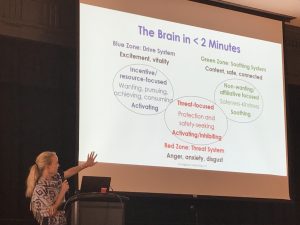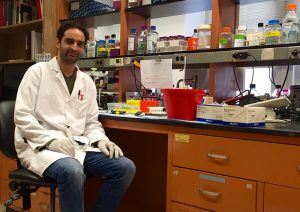Enter your address to receive notifications about new posts to your email.
Featured
-
Featured
Random Factors: An Interview with 2017 Thomas Hunt Morgan Medal Recipient Richard C. Lewontin
The Thomas Hunt Morgan Medal is awarded to an individual member of the Genetics Society of America for lifetime achievement in the field of genetics. It recognizes the full body of work of an exceptional geneticist. The 2017 recipient is Richard C. Lewontin, whose contributions and influence have profoundly shaped the field of evolutionary genetics.…
-
Featured
Treasure Your Exceptions: An Interview with 2017 George Beadle Award Recipient Susan A. Gerbi
The Genetics Society of America’s George W. Beadle Award honors individuals who have made outstanding contributions to the community of genetics researchers and who exemplify the qualities of its namesake. The 2017 recipient is Susan A. Gerbi, who has been a prominent leader and advocate for the scientific community. In the course of her research…
-
Featured
Who would be hurt by higher taxes for graduate students? All of us.
What is #GradTax about? The US research enterprise is under threat by proposed tax changes that would make it difficult for all but the wealthiest students to undertake graduate training. Restricting access to advanced training would damage the nation’s ability to grow, innovate, discover new medicines, bring new technologies to market, and adapt to a…
-
Featured
Putting active learning into practice: an interview with PALM fellow Christopher Baker and PALM mentor Michelle Smith
Are you a postdoc looking for hands-on education experience and mentoring? Or a faculty member interested in bringing evidence-based, effective active learning strategies into your classroom? The PALM (Promoting Active Learning and Mentoring) network helps faculty and postdoctoral fellows gain hands-on experience and long-term mentorship in putting active learning strategies into practice. GSA is proud…
-
Featured
Stressed-out worms hit the snooze button
When you catch a nasty cold, curling up in bed to sleep may be the only activity you can manage. Sleeping in response to stress isn’t a uniquely human behavior: many other animals have the same reaction, and it’s not clear why. While the circadian sleep that follows the pattern of the clock has been…
-
Featured
Behind the Cover: Genetic ancestry in Colombia
Over three centuries, as many as a million enslaved people were shipped to the Colombian port of Cartagena. From this hub of the slave trade, European colonists took Africans to labor in many places across the Americas, including the gold mines of the Chocó region. Today, people from Chocó often proudly identify as Afro-Colombian, while…
-
Featured
Career Development Symposium Report: Ethical and Inspiring Mentorship in STEM
Guest post by Pinar Gurel. GSA is currently accepting proposals from students and postdocs for the next round of Career Development Symposia. Gain leadership experience and serve the early career scientist community! Among the many roles that scientists play, mentoring younger scientists is one that researchers are rarely trained for. In the current STEM research environment,…
-
Featured
Welcome to the new members of the GSA Board of Directors!
We are pleased to announce the election of four new leaders to the GSA Board of Directors: 2018 Vice-President / 2019 President Terry Magnuson Sarah Graham Kenan Professor, Department of Genetics, University of North Carolina at Chapel Hill and Vice Chancellor for Research, UNC Chapel Hill Terry Magnuson investigates the role of genes in unique epigenetic…
-
Featured
A career panel changed Chris Cherry’s path from fruit fly geneticist to patent lawyer
Chris Cherry, a patent lawyer at Buchanan Ingersoll & Rooney PC, talks about the need for biology PhDs in patent law and how he learned that leaving research does not mean the end of being involved in cutting-edge science. In the Decoding Life series, we talk to geneticists with diverse career paths, tracing the many directions possible after…
-
Featured
How the fruit fly’s daily rhythms led to big discoveries—and a Nobel Prize
The unassuming fruit fly has paved the way for another big scientific win: on October 2nd, the Nobel Assembly awarded the 2017 Nobel Prize in Physiology or Medicine to Jeffrey C. Hall, Michael Rosbash, and Michael W. Young for their discoveries of the molecular mechanisms behind circadian rhythms. These biologists have spent their careers studying…
-
Featured
Aashiq Mirza on the importance of being collaborative for a successful career in academic research
Interview with Aashiq Mirza, postdoctoral fellow at Weill Cornell Medicine, talks about acquiring interdisciplinary skills and practical habits for success during the early stages of a research career. In the Decoding Life series, we talk to geneticists with diverse career paths, tracing the many directions possible after research training. This series is brought to you by the GSA Early Career…











